Read more about Carville
At CaliSphere there's this picture:
 |
| Villa Miramar (from which the bicycle trips would start) -- Wheelman's [i.e. Wheelmen's] Rest, on the Great Highway. |
From Bicycles West:
The Villa Miramar, a bar at the end of today's Irving Street, put up a sign advertising itself as the "Wheelmen's Rest." North of the park, Adolph Sutro had a three-story chalet erected on the southwest corner of La Playa and Fulton Street that he named "Cycler's Rest."
Outside Lands podcast has an episode about Sutro's Cycler's Rest, which was at LaPlaya and Fulton.
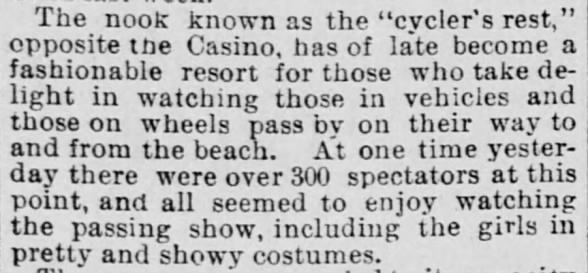 Cycler's Rest Mon, Nov 25, 1895 – Page 5 · The San Francisco Call (San Francisco, San Francisco, California, United States of America) · Newspapers.com
Cycler's Rest Mon, Nov 25, 1895 – Page 5 · The San Francisco Call (San Francisco, San Francisco, California, United States of America) · Newspapers.com
In the Crocker-Langley San Francisco Business Directory, H.S. Crocker Company, 1899 we learn why the building says "Barta" (I believe the "I" in the address refers to what is now Irvine):
Villa Miramar, Charles J Barta propr., Ocean Boulevard and I
He had interesting problems:
Charles J. Barta, manager of the Miramar Villa, on the Ocean Beach, has a flying machine on his hands of which he would like to be rid.
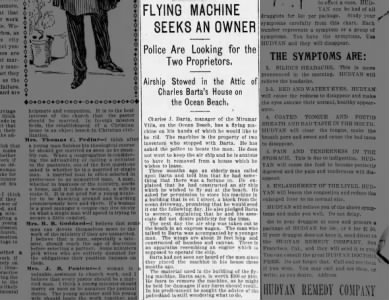 FLYING MACHINE SEEKS AN OWNER Wed, Apr 12, 1899 – 12 · The San Francisco Examiner (San Francisco, California, United States of America) · Newspapers.com
FLYING MACHINE SEEKS AN OWNER Wed, Apr 12, 1899 – 12 · The San Francisco Examiner (San Francisco, California, United States of America) · Newspapers.com
Below you can see a group of wheelmen - finance professionals and the owner of a large department store - set up their own clubhouse, I think behind Villa Miramar. The name, or concept of "Wheelmen's Rest" was not unique to San Francisco. Cycling was so popular, and the people doing it had enough money and time that these things were all over the country. It was good business.
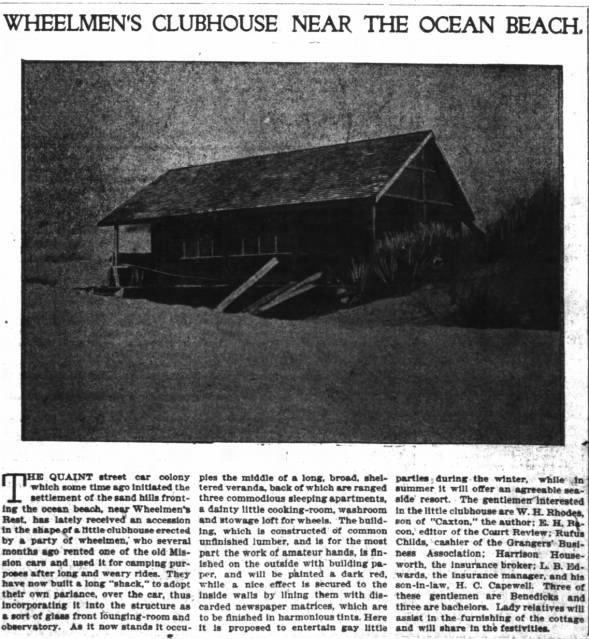 WHEELMEN'S CLUBHOUSE NEAR THE OCEAN BEACH. Sun, Oct 30, 1898 – Page 8 · San Francisco Chronicle (San Francisco, San Francisco, California) · Newspapers.com
WHEELMEN'S CLUBHOUSE NEAR THE OCEAN BEACH. Sun, Oct 30, 1898 – Page 8 · San Francisco Chronicle (San Francisco, San Francisco, California) · Newspapers.comTHE QUAINT street car colony which some time ago Initiated the settlement of the sand hills fronting the ocean beach, near Wheelmen's Rest, has lately received an accession in the shape of a little clubhouse erected by a party of wheelmen, who several months ago rented one of the old Mission cars and used it for camping purposes after long and weary rides. They have now built a long "shack," to adopt their own parlance, over the car, thus incorporating it into the structure as a sort of glass front lounging-room and observatory. As it now stands It occupies the middle of a long, broad, sheltered veranda back of which are ranged three commodious sleeping apartments. a dainty little cooking-room, washroom and stowage loft for wheels. The building, which is constructed of common unfinished lumber, and is for the most part the work of amateur hands, is finished on the outside with building paper, and will be painted a dark red, while a nice effect is secured to the inside walls by lining them with discarded newspaper matrices, which are to be finished in harmonious tints. Here it is proposed to entertain gay little parties during the winter, while in summer it will offer an agreeable seaside resort. The gentlemen interested in the little clubhouse are W. H. Rhodes, son of "Caxton," the author; E. H. Bacon, editor of the Court Review; Rufus Childs, cashier of the Grangers' Business Association; Harrison Houseworth, the insurance broker; L. B. Edwards, the insurance manager, and his son-in-law H. C. Capewell. Three of these gentlemen are Benedicks and three are bachelors. Lady relatives will assist In the furnishing of the cottage and will share in the festivities.
The article is from 1898. The flag in the photo at top, of WHEELMENS REST looks like a 44-star flag, which was 1891-1896, but it also looks old. I'd guess this photo is from around the turn of the century, 1900.
I want a bike clubhouse out on the beach. What a good idea!
That part of San Francisco was as yet undeveloped, at least when this 1895 UGS map was made:
 |
| San Francisco, CA 1895 USGS map |
Wheelmen's Rest would have been about where those two - north-south and east-west - rail lines intersected, on the west shore of San Francisco, in the map. If you zoom in close on the photo at top, there are two different signs advertising lots for sale.
Women cyclists had much fun with their own clubhouse at Ocean Beach. I found this article by Robert O'Brien on SFGate (published on the web in 2011, but Mr. O'Brien died in 2004 at 93, so it is probably much older):
In any event, there was an element that braved the dangers of the Sunset dunes, a hardy group of lady cyclists. In 1895, the ladies, known collectively as the Falcon Bicycle Club, obtained from Mayor Sutro an ancient horse car that had once been part of the rolling stock of the North Beach and Mission horse car line. For the record, the officers of this club were Mrs. Robert H. Fitzgerald, president; Mrs. William Leonard, secretary; Mrs. Viola Rice, treasurer; Mrs. William Miller and Mrs. F. Lisinsky, vice presidents.
The old horse car became their clubhouse. It was established and presumably anchored, at a point that would now be, roughly, the intersection of 47th Avenue and Lincoln Way. This unusual setting for their clubhouse I find attractively described as a place "lost among wind-piled pyramids of sand, at the feet of which were many brackish pools connected by serpentine rivulets and shadowed by acacia tangles."
To this Bedouin retreat the Falcons swiftly brought the feminine touch, and an interior photograph of the car shows curtains in the windows, a rug on the floor, a painted ceiling, chairs, a sofa, lockers and a dining room table large enough to seat 28. Around the outside of the car was a porch from which you could peer across the brackish pools into the acacia thicket.
Many jolly times were had at the clubhouse on the Sunday afternoons of the late '90s and the years immediately preceding the 1906 disaster, and some of the most noted figures of the day regarded the old horse car completely charming.
"This is the most pleasant place of rest I have ever found," said Collis P. Huntington of the "Big Four" after his visit. Among the others who added a glamorous touch to the Sunday afternoons were Miss Moore and Miss Murphy, "leading literary lights of London"; Xavier Martinez and Brubecker, the artists; W.W. Stow, John Mackay, the Comstock king; Arthur McEwen, Ambrose Bierce and the entire membership of the San Francisco Press Club, and such men about town as J. Downey Harvey, Herman Oelrichs and John Hammersmith.
Most of the guests, it appears, did not make the trek by bicycle, but rather were driven out in their carriages and phaetons. Mayor Sutro, when he visited the Falcons Bicycle Club, rode his black horse down the beach from Sutro Heights and left it outside in the care of his groom while he partook of a picnic lunch and listened to the sparkling conversation that a discreet glass of sherry or port drew from the Falcons and their guests.
But, as time passed, cycling as a vogue among the ladies gave way to golf, and the clubhouse fell into disuse. A few years after that, the Oceanside Improvement Club adopted as its program the slogan, "Make clean today by sweeping and burning up the debris of yesterday." It had in mind, of course, Carville.
On the night of July 4, 1913, several hundred members gathered about the now shabby clubhouse and cheered as Alexander Russell, their president, set fire to it, and simultaneously detonated $10 of fireworks.
"This is indeed a historic occasion," he said as he held the torch to the horse car. "We members of the Oceanside Improvement Club have acted. We have taken the 'car' out of Carville."
The flames crackled through the tindery old car. A few hours later, it was ashes and smoking embers.
Before they were the Falcon Bicycle Club, they were apparently the "G. G. C. C." That might mean Golden Gate Cycling Club?
 Wed, Apr 8, 1896 – 7 · The San Francisco Examiner (San Francisco, California, United States of America) · Newspapers.com
Wed, Apr 8, 1896 – 7 · The San Francisco Examiner (San Francisco, California, United States of America) · Newspapers.com
A photo of the Falcon Bicycle Club, from the Bicycles West post on the Outside Lands blog:
 | |
|
It wasn't only wheelmen taking to the park and beach roads. Scores of women took up riding, some shockingly forsaking skirts and dresses for more comfortable blousy-trousered "bloomers." (The Examiner reporter who did the one-day Golden Gate Park census tabulated that bloomer-wearers outnumbered skirt-wearers 4 to 1.) One club of female cyclists, the Falcons, actually had a major role in starting the community of Carville by renting an old horsecar from Adolph Sutro to use as a clubhouse.
After hard rides, the Falcons took naps on the soft, long seats of the old transit vehicle. They built a shed addition on the back of the car to store their bikes, and installed a kitchen with three coal oil stoves. The members held frequent dinner parties, often with tongue-in-cheek descriptions sent to the newspapers to mock conventional society recaps. An outdoor banquet in August 1896 was listed to have entrées of "brown beans, baked beans, barnacles, spider toes, frog legs, and Frangipanni." A men's bicycle club soon followed the Falcons and also rented a car clubhouse from Sutro.
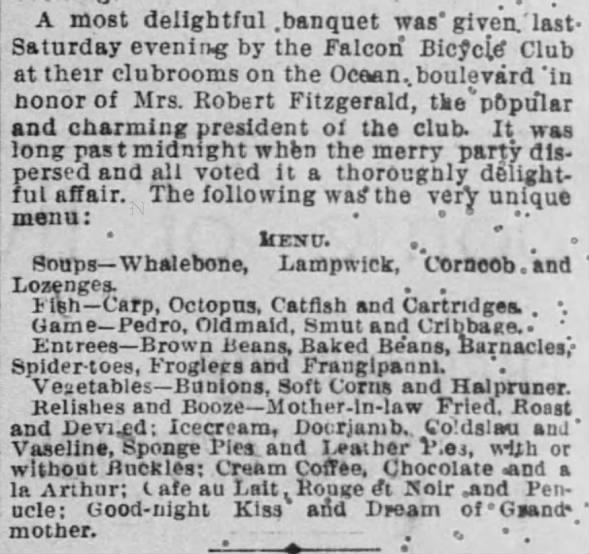 Falcon Bicycle Club Banquet in Honor of Mrs. Robert Fitzgerald. Sun, Aug 2, 1896 – Page 20 · The San Francisco Call (San Francisco, San Francisco, California, United States of America) · Newspapers.com
Falcon Bicycle Club Banquet in Honor of Mrs. Robert Fitzgerald. Sun, Aug 2, 1896 – Page 20 · The San Francisco Call (San Francisco, San Francisco, California, United States of America) · Newspapers.com
I think the menu is a joke on the reader!
Falcon Bicycle Club Banquet in Honor of Mrs. Robert Fitzgerald
A most delightful banquet was given, last Saturday evening by the Falcon Bicycle Club at their clubrooms on the Ocean boulevard in honor of Mrs. Robert Fitzgerald, the popular and charming president of the club. It was long past midnight when the merry party dispersed and all voted it a thoroughly delightful affair. The following was the very unique menu:
MENU.
Soups — Whalebone, Lampwick, Corncob and Lozenges.
Fish — Carp, Octopus, Catfish and Cartridges.
Game — Pedro, Oldmald, Smut and Cribbage.
Entrees— Brown Beans, Baked Beans, Barnacles, Spider-toes, Froglegs and Frangipanni.
Vegetables — Bunions, Soft Corns and Halpruner.
Relishes and Booze — Mother-in-law Fried, Roast and Deviled; Icecream, Doorjamb, Coldslau and Vaseline, Sponge Pies and Leather Pies, with or without Buckles; Cream Coffee, Chocolate and a la Arthur; Cafe au Lait, Rouge et Noir and Penucle; Good-night Kiss and Dream of Grandmother
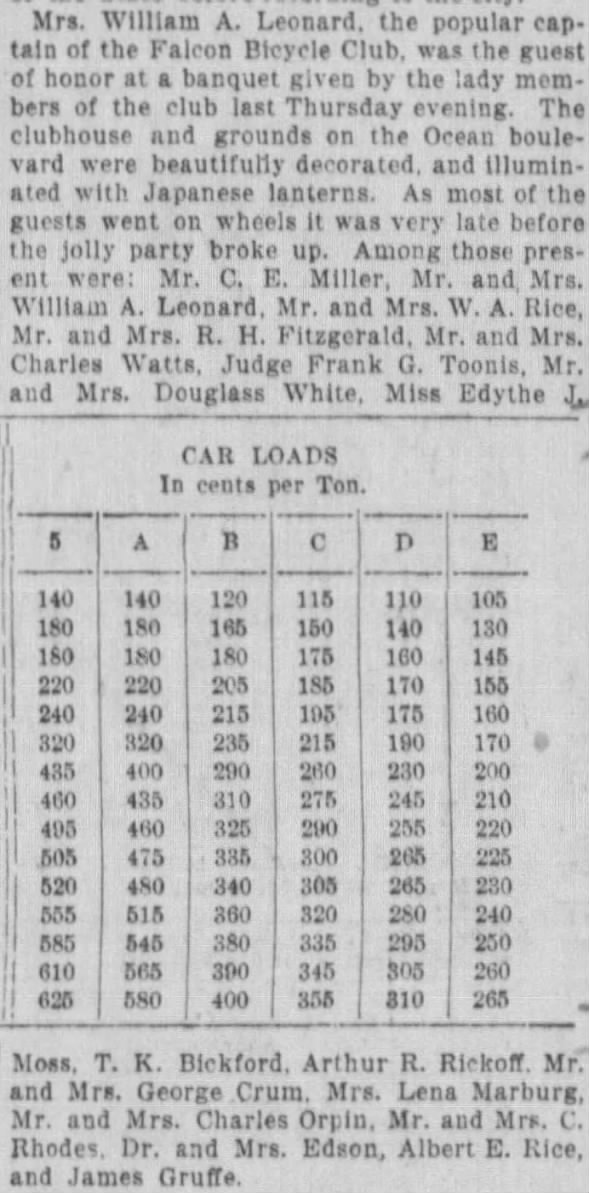 Sun, Aug 23, 1896 – 17 · The San Francisco Examiner (San Francisco, California, United States of America) · Newspapers.com
Sun, Aug 23, 1896 – 17 · The San Francisco Examiner (San Francisco, California, United States of America) · Newspapers.com
There's a lot more of wonderful information about Carville in this Winter 1978 / 1979 edition of the California Historical Society, written by Natalie Jahraus Cowan. Stop what you're doing and go read it, she mentions the Falcon Bicycle Club a few times. Here are some great photos from the article:
Priced at $10 and $20 in an 1895 newspaper advertisement (page 310), surplus horse-cars were put to use as modular shops, play-houses, and homes. Four cars linked to make an ark on Belvedere Bay and Col. Daileys Carville coffee house, the Annex, were sketched for San Francisco Examiner readers in 1895.
 |
| Notice the Villa Miramar at right. |
Scattered on the sand like toys in this strangely peaceful photograph made around 1900 are outmoded horse-drawn streetcars.
A family album snapshot of a favorite multistory vacation cottage.
At least four cars are visible in the elaborate Carville structure below. Rounded lines suggest "Moderne" architecture of a later time. Dashboards from front platforms make up the fence along the plank sidewalk.
In the 1920's car-houses provided inexpensive, even rent-free, housing to residents in the Sunset District.
After the earthquake and fire, horse-cars provided temporary housing, and as yean passed they were frequently converted to permanent shelters.
The Mr. and Mrs. Robert H. Fitzgerald are mentioned in Cowan's article - her name was Ida F. Fitzgerald:
Bicycling fever was high in San Francisco in 1895, and one of the cars in Dailey's enclave was the clubhouse of a group of women cyclists named the Falcons. The women refurbished the old North Beach and Mission car with matting and blue and white Delft-patterned curtains. The popular club soon expanded into other cars and added a lean-to for their bicycles. For their banquets they devised a table large enough to seat twenty-eight persons, built to swing away to the ceiling when not in use. If the car was too crowded inside to reach the kitchen, one could always run around the outside and enter by the back platform.
When not cycling on the new paths through the park to the beach, the Falcons enjoyed bathing in the ocean "when no one was watching" or playing Whist. "Each 'weekend' found gathered here a merry convocation of the fairest of San Francisco's brilliant women to which was added a large number of the leading professional men, artists, writers and travellers. . . ." Among those notables visiting the "car that ran into a house" were Ambrose Bierce, Arthur McEwen, and the "entire membership of the Press Club;" Mayor Sutro, who rode down frequently from Sutro Heights on his black horse; artist Xavier Martinez; and W. W. Stow, John Mackay, and Collis Huntington, who declared, "This is the most pleasant little place of rest I have ever found."
In the late nineties visitors might stray over the dunes from the Falcon's car to the picnic car of the "Fuzzy Bunch," long-haired Bohemians of the day. Among the artists, musicians, and writers who made up the group were Gelett Burgess, Maynard Dixon, Arnold Genthe, Porter Garnett, Will Irwin, Jack London, Bruce Porter, George Sterling, Ina Coolbrith, Anna Strunsky, and Isabel Frazer. Edwin Emerson writes of visiting the car in 1905 with his future wife, Mary Edith Griswold, known as "Maisie" among the Bohemians. The fuzzies' patron angel was Dr. Cross, a prosperous physician who bought the car from Mayor Sutro and who stocked it with "eatables and drinkables on many occasions when many of the fuzzies gathered there to make merry." Dr. Cross habitually entrusted the padlock key "to a friendly grocer near the Dunes, from whom it could be obtained at all times, together with further eatables and drinkables to be credited in the grocer's ledger to the generous doctor."
And:
Before the turn of the century car-houses were used as residences, as well as for recreational purposes. Contemporary accounts differ in identifying the first person to live permanently in one of the cars at Carville. They allude variously to an Italian immigrant; a sea captain lonesome for the sea (possibly Colonel Dailey in his seaman's coat, although he lived in a real-estate shack); and a horse-car conductor who retired to live in his old car rather than work on an electric trolley. A more recent article suggests that the Robert H. Fitzgeralds were the first permanent car residents. Fitzgerald was described as an influential city official who found a car to be a quiet retreat from the favor-seekers who hounded him. The Fitzgeralds were named in early accounts as renters in Colonel Dailey's resort when Ida Fitzgerald was president of the Falcon Bicycle Club. They may well have chosen permanent beach life as early as 1896 when Fitzgerald's city address disappears from the city directory and he is listed only by his title, deputy city clerk.
In the book People, Power, Places, the authors (Sally Ann McMurry and Annmarie Adams) write about Carville, or Cartown, the place near Ocean Beach where old street cars were abandoned, and often turned into homes:
Trolley cottages proliferated in the 1890s as large numbers of horse-drawn streetcars were replaced by electric trolleys. Ex-horsecars were spotted along the coast from Rhode Island to suburban New York, “perched up on top of some breezy bluff on the sandy shore, or in some quiet, shaded nook, affording temporary habitation for families, fishermen, hunters, etc."23 Obsolete San Francisco horsecars entered new lives as “economical and highly picturesque” beach cabins, clubhouses, and permanent residences—as well as shops, restaurants, and an Episcopalian church-at Cartown, or Carville (fig. 2.1), south of Golden Gate Park.24 By 1900 there were more than one hundred cars, some set in the hollows of dunes and surrounded by nasturtiums, while others were stacked atop buildings as "skyscrapers” for the ocean view through broad bands of windows. The community's peculiar appearance seemed just right for San Francisco's bohemian society, whose "facetious idiosyncrasies” led them to give their "car-palaces.” such names as Villa Miramar and Chateau Navarre.25 Interiors ranged from the shabby and makeshift to tasteful examples of the aesthetic movement. Some had sleeping compartments whose efficient use of space reminded visitors of railroad sleeping cars, houseboats, or ship cabins.
Cyclers' Rest appears to have been on a decline, due to bad water (no fresh city water supply, near the ocean), crime (far from town) and erosion from the ocean. In 1904:
The end of Carville came about on July 4, 1913:
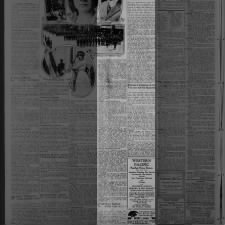 CARVILLE MAKES PYRE FOR JULY 4 Sat, Jul 5, 1913 – Page 8 · The San Francisco Call (San Francisco, San Francisco, California, United States of America) · Newspapers.com
CARVILLE MAKES PYRE FOR JULY 4 Sat, Jul 5, 1913 – Page 8 · The San Francisco Call (San Francisco, San Francisco, California, United States of America) · Newspapers.com
This is what the area looks like today, looking west from the Great Highway, at the end of Irving street. The photo at the top of this post was probably taken looking east, but if you spin the view around, below, you'll just see houses and streets. Those dunes in the photo, behind Villa Miramar are probably the slight hills east of Great Highway.The end of Carville came about on July 4, 1913:
 CARVILLE MAKES PYRE FOR JULY 4 Sat, Jul 5, 1913 – Page 8 · The San Francisco Call (San Francisco, San Francisco, California, United States of America) · Newspapers.com
CARVILLE MAKES PYRE FOR JULY 4 Sat, Jul 5, 1913 – Page 8 · The San Francisco Call (San Francisco, San Francisco, California, United States of America) · Newspapers.comCARVILLE MAKES PYRE FOR JULY 4
The long drawn, wailing bugle notes of "taps," the crackling of flames and the murmur of a great crowd marked the passing of a town last night. Carville is no more. It went up in smoke and fire, a luminous episode of the San Francisco 1913 celebration of Independence day.
Long aso Carville, once a considerable suburb of San Francisco, dwindled to a comparatively small place. Accidental fires, the breaking up of some of the unique residences and the removal of others, had diminished the little town within a city until last night, when the torch was put to what was left, there were only six of the old time horse cars to be destroyed.
It was the Ocean Side Improvement club that decided upon the burning of Carville as its contribution to the program of the day. The result ran far ahead of anything that the club could have expected. For Carville held a sentimental place in the hearts of the people of San Francisco, and thousands made the long trip out to the beach to witness the passing of the old landmark.
Automobiles by hundreds flashed headlights from the beach highway above Carville and from the streets bounding the humble but well known suburb.
Men, women and children, not to say anything of the dogs, waded through the sand about the old horse cars or climbed to coigns of vantage on the higher ground surrounding the village and watched the flames lick up the ancient vehicles that not so many years ago were considered fit to transport the people of the city from point to point, but that have now been superseded by swiftly moving electric cars.
Probably among the crowding thousands were some of those who for year's used the abandoned horse cars as homes - and found them not uncomfortable. But if they were present, they were lost among the hundreds of couples of happy young people, who wandered, arm in arm, about the place where the flames were making a glorious end of the old homes.
The burning cars just suited the omnipresent small boy, who was there in swarming crowds. He whooped with delight and did his noisy best to add to the excitement by hurling cannon crackers into the flaming chariots or attaching pinwheels to the crumbling roofs. A fourth of July celebration today is not much like the hilarious, noisy celebration of half a generation ago, but the burning of Carville last night added a touch that made the windup of San Francisco's 1913 celebration not unlike those of the earlier days of the republic.
It was announced that the Park Commissioners are about to erect a rustic house for a wheelmen's rest at the end of the Ocean boulevard, near Ingleside.
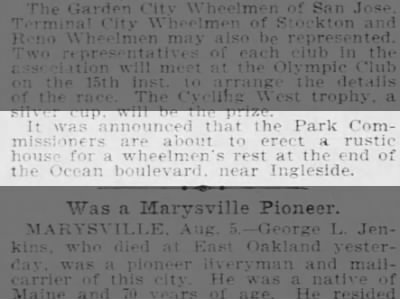 Sun, Aug 6, 1899 – Page 8 · The San Francisco Call (San Francisco, San Francisco, California, United States of America) · Newspapers.com
Sun, Aug 6, 1899 – Page 8 · The San Francisco Call (San Francisco, San Francisco, California, United States of America) · Newspapers.com
Poor Bosco
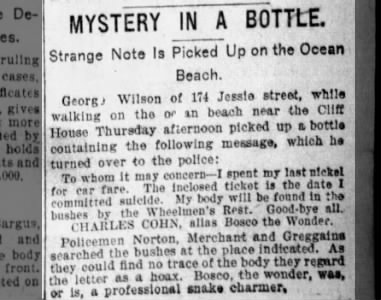 MYSTERY IN A BOTTLE. Sat, Jun 21, 1902 – 7 · The San Francisco Examiner (San Francisco, California, United States of America) · Newspapers.com
MYSTERY IN A BOTTLE. Sat, Jun 21, 1902 – 7 · The San Francisco Examiner (San Francisco, California, United States of America) · Newspapers.com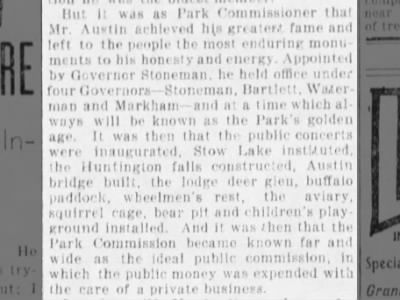 Joseph Austin, Park Commissioner, takes credit for Wheelmen's Rest. Sat, Apr 19, 1902 – 1 · The San Francisco Examiner (San Francisco, California, United States of America) · Newspapers.com
Joseph Austin, Park Commissioner, takes credit for Wheelmen's Rest. Sat, Apr 19, 1902 – 1 · The San Francisco Examiner (San Francisco, California, United States of America) · Newspapers.comA Notable Run of the San Francisco Club. "The park observatory on the beach, which is becoming known as "Wheelmen's Rest," was the first stopping point, and here a rest of twenty minutes ws taken, while the tourists made more pleasant acquaintances and secured more interesting views.
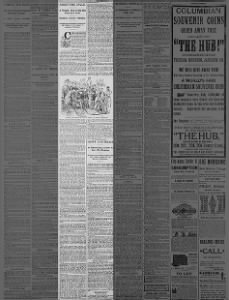 ABOUT THE CYCLE. Mon, Jan 9, 1893 – Page 8 · The San Francisco Call (San Francisco, San Francisco, California, United States of America) · Newspapers.com
ABOUT THE CYCLE. Mon, Jan 9, 1893 – Page 8 · The San Francisco Call (San Francisco, San Francisco, California, United States of America) · Newspapers.com
A fight to a finish with bare fists was fought in the sand dues of the ocean beach, near Wheelmen's Rest, about 4 o'clock last Saturday afternoon.
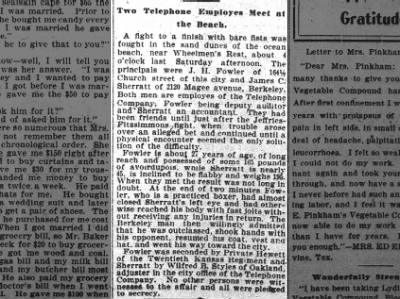 Two Telephone Employes Meet at the Beach Tue, Oct 17, 1899 – Page 5 · San Francisco Chronicle (San Francisco, San Francisco, California) · Newspapers.com
Two Telephone Employes Meet at the Beach Tue, Oct 17, 1899 – Page 5 · San Francisco Chronicle (San Francisco, San Francisco, California) · Newspapers.comRoy Graves took the photo at the top of this post. Here are more of his photos. His obituary:
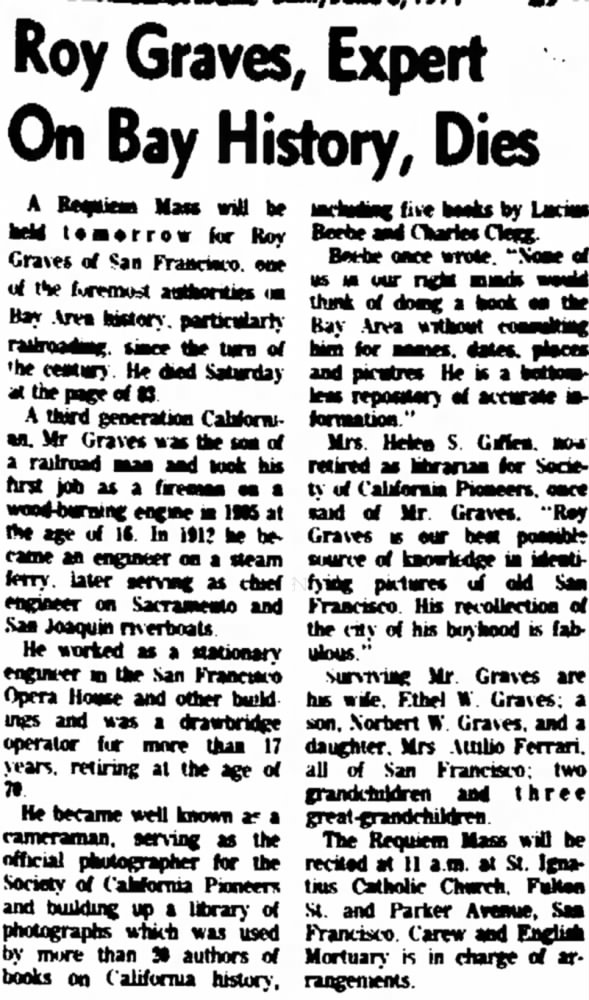 Roy Graves obituary Sun, Jun 6, 1971 – Page 29 · Oakland Tribune (Oakland, Alameda, California, United States of America) · Newspapers.com
Roy Graves obituary Sun, Jun 6, 1971 – Page 29 · Oakland Tribune (Oakland, Alameda, California, United States of America) · Newspapers.com






Comments
Post a Comment